β-Phase Enhancement of Force Spun Composite Nanofibers for Sensing Applications
Abstract
:1. Introduction
2. Materials and Methods
2.1. Material
2.2. Synthesis of the BaTiO3 Nanoparticles
2.3. Fabrication of Piezoelectric Sensor
3. Characterizations of the Synthesized BaTiO3 and Composite Nanofibers
4. Results and Discussions
4.1. Morphology and EDS Elemental Mapping
4.2. XRD Measurements
4.3. Fourier-Transform Infrared Spectroscopy Measurements
4.4. Thermogravimetric Analysis
4.5. Piezoelectric Tests
5. Conclusions
Supplementary Materials
Author Contributions
Funding
Institutional Review Board Statement
Data Availability Statement
Acknowledgments
Conflicts of Interest
References
- Zhao, Z.; Dai, Y.; Dou, S.; Liang, J. Flexible nanogenerators for wearable electronic applications based on piezoelectric materials. Mater. Today Energy 2021, 20, 100690. [Google Scholar] [CrossRef]
- Ferrero-Martín, F.J. Sensors for the Internet of things. In Sensors in the Age of the Internet of Things; Postolache, E.O.A., Ed.; The Institution of Engineering and Technology (IET): London, UK, 2019; pp. 35–61. [Google Scholar] [CrossRef]
- Zhou, H.; Zhang, Y.; Qiu, Y.; Wu, H.; Qin, W.; Liao, Y.; Yu, Q.; Cheng, H. Stretchable piezoelectric energy harvesters and self-powered sensors for wearable and implantable devices. Biosens. Bioelectron. 2020, 168, 112569. [Google Scholar] [CrossRef]
- Yang, T.; Pan, H.; Tian, G.; Zhang, B.; Xiong, D.; Gao, Y.; Yan, C.; Chu, X.; Chen, N.; Zhong, S.; et al. Hierarchically structured PVDF/ZnO core-shell nanofibers for self-powered physiological monitoring electronics. Nano Energy 2020, 72, 104706. [Google Scholar] [CrossRef]
- Yu, D.; Zheng, Z.; Liu, J.; Xiao, H.; Huangfu, G.; Guo, Y. Superflexible and Lead-Free Piezoelectric Nanogenerator as a Highly Sensitive Self-Powered Sensor for Human Motion Monitoring. Nano-Micro Lett. 2021, 13, 117. [Google Scholar] [CrossRef] [PubMed]
- Mokhtari, F.; Azimi, B.; Salehi, M.; Hashemikia, S.; Danti, S. Recent advances of polymer-based piezoelectric composites for biomedical applications. J. Mech. Behav. Biomed. Mater. 2021, 122, 104669. [Google Scholar] [CrossRef]
- Chamankar, N.; Khajavi, R.; Yousefi, A.A.; Rashidi, A.; Golestanifard, F. A flexible piezoelectric pressure sensor based on PVDF nanocomposite fibers doped with PZT particles for energy harvesting applications. Ceram. Int. 2020, 46, 19669–19681. [Google Scholar] [CrossRef]
- Shi, K.; Sun, B.; Huang, X.; Jiang, P. Synergistic effect of graphene nanosheet and BaTiO3 nanoparticles on performance enhancement of electrospun PVDF nanofiber mat for flexible piezoelectric nanogenerators. Nano Energy 2018, 52, 153–162. [Google Scholar] [CrossRef]
- Zhou, F.; Zhou, R.; Gao, D. Influences of surfactant (PVA) concentration and pH on the preparation of copper nanoparticles by electron beam irradiation. Radiat. Phys. Chem. 2008, 77, 169–173. [Google Scholar] [CrossRef]
- Banerjee, S.; Bairagi, S.; Ali, S.W. A critical review on lead-free hybrid materials for next generation piezoelectric energy harvesting and conversion. Ceram. Int. 2021, 47, 16402–16421. [Google Scholar] [CrossRef]
- He, C.-H.; Li, X.-W.; Liu, P.; Li, Y. Bubbfil spinning for fabrication of PVA nanofibers. Therm. Sci. 2015, 9, 743–746. [Google Scholar] [CrossRef]
- Lu, L.; Ding, W.; Liu, J.; Yang, B. Flexible PVDF based piezoelectric nanogenerators. Nano Energy 2020, 78, 105251. [Google Scholar] [CrossRef]
- Kalimuldina, G.; Turdakin, N.; Abay, I.; Medeubayev, A.; Nurpeissova, A.; Adair, D.; Bakenov, Z. A review of piezoelectric PVDfilm by electrospinning and its applications. Sensors 2020, 20, 5214. [Google Scholar] [CrossRef]
- Alhasssan, Z.A.; Burezq, Y.S.; Nair, R.; Shehata, N. Polyvinylidene Difluoride Piezoelectric Electrospun Nanofibers: Review in Synthesis, Fabrication, Characterizations, and Applications. J. Nanomater. 2018, 2018, 8164185. [Google Scholar] [CrossRef]
- Ibtehaj, K.; Jumali, M.H.H.; Al-Bati, S. A novel facile preparation method of self-polarized Poly(vinylidene fluorides) nanofiber for high-performance piezoelectric nanogenerator. Polymer 2020, 208, 122956. [Google Scholar] [CrossRef]
- Ebnesajjad, S. Introduction to Fluoropolymers. In Applied Plastics Engineering Handbook; William Andrew Publishing: Norwich, NY, USA, 2017; pp. 55–71. [Google Scholar] [CrossRef]
- Yan, J.; Liu, M.; Jeong, Y.G.; Kang, W.; Li, L.; Zhao, Y.; Deng, N.; Cheng, B.; Yang, G. Performance enhancements in poly(vinylidene fluoride)-based piezoelectric nanogenerators for efficient energy harvesting. Nano Energy 2018, 56, 662–692. [Google Scholar] [CrossRef]
- Goldbach, J.T.; Amin-Sanayei, R.; He, W.; Henry, J.; Kosar, W.; Lefebvre, A.; O’brien, G.; Vaessen, D.; WOOD, K.; Zerafati, S. Commercial Synthesis and Applications of Poly(Vinylidene Fluoride). In RSC Polymer Chemestry 2017, 2017, 127–157. [Google Scholar] [CrossRef]
- Rahman, A.; Lee, B.-C.; Phan, D.-T.; Chung, G.-S. Fabrication and characterization of highly efficient flexible energy harvesters using PVDF–graphene nanocomposites. Smart Mater. Struct. 2013, 22, 085017. [Google Scholar] [CrossRef]
- El Achaby, M.; Arrakhiz, F.; Vaudreuil, S.; Essassi, E.; Qaiss, A. Piezoelectric β-polymorph formation and properties enhancement in graphene oxide—PVDF nanocomposite films. Appl. Surf. Sci. 2012, 258, 7668–7677. [Google Scholar] [CrossRef]
- Huang, T.; Yang, S.; He, P.; Sun, J.; Zhang, S.; Li, D.; Meng, Y.; Zhou, J.; Tang, H.; Liang, J.; et al. Phase-Separation-Induced PVDF/Graphene Coating on Fabrics toward Flexible Piezoelectric Sensors. ACS Appl. Mater. Interfaces 2018, 10, 30732–30740. [Google Scholar] [CrossRef]
- Luo, Y.; Zhao, L.; Luo, G.; Li, M.; Han, X.; Xia, Y.; Li, Z.; Lin, Q.; Yang, P.; Dai, L.; et al. All electrospun fabrics based piezoelectric tactile sensor. Nanotechnology 2022, 33, 415502. [Google Scholar] [CrossRef]
- Cho, H.; Kouh, T. Static Tactile Sensing Based on Electrospun Piezoelectric Nanofiber Membrane. Sensors 2022, 22, 6779. [Google Scholar] [CrossRef]
- Tao, M.M.; Liu, F.; Ma, B.R.; Xue, L.X. Effect of solvent power on PVDF membrane polymorphism during phase in-version. Desalination 2013, 316, 137–145. [Google Scholar] [CrossRef]
- Gee, S.; Johnson, B.; Smith, A. Optimizing electrospinning parameters for piezoelectric PVDF nanofiber membranes. J. Membr. Sci. 2018, 563, 804–812. [Google Scholar] [CrossRef]
- Russo, F.; Ursino, C.; Avruscio, E.; Desiderio, G.; Perrone, A.; Santoro, S.; Galiano, F.; Figoli, A. Innovative Poly (Vinylidene Fluoride) (PVDF) Electrospun Nanofiber Membrane Preparation Using DMSO as a Low Toxicity Solvent. Membranes 2020, 10, 36. [Google Scholar] [CrossRef]
- He, Z.; Rault, F.; Lewandowski, M.; Mohsenzadeh, E.; Salaün, F. Electrospun PVDF Nanofibers for Piezoelectric Applications: A Review of the Influence of Electrospinning Parameters on the β Phase and Crystallinity Enhancement. Polymers 2021, 13, 174. [Google Scholar] [CrossRef]
- Zhang, H.; He, R.; Niu, Y.; Han, F.; Li, J.; Zhang, X.; Xu, F. Graphene-enabled wearable sensors for healthcare monitoring. Biosens. Bioelectron. 2021, 197, 113777. [Google Scholar] [CrossRef] [PubMed]
- Faraz, M.; Singh, H.H.; Khare, N. A progressive strategy for harvesting mechanical energy using flexible PVDF-rGO-MoS2 nanocomposites film-based piezoelectric nanogenerator. J. Alloys Compd. 2021, 890, 161840. [Google Scholar] [CrossRef]
- Sarkar, K.; Gomez, C.; Zambrano, S.; Ramirez, M.; de Hoyos, E.; Vasquez, H.; Lozano, K. Electrospinning to Forcespinning™. Mater. Today 2010, 13, 12–14. [Google Scholar] [CrossRef]
- Vazquez, B.; Vasquez, H.; Lozano, K. Preparation and characterization of polyvinylidene fluoride nanofibrous membranes by forcespinning™. Polym. Eng. Sci. 2012, 52, 2260–2265. [Google Scholar] [CrossRef]
- Hoejin, K.; Torres, F.; Mingyue, L.; Yirong, L.; Tseng, T.-L.B. Fabrication and characterization of 3D printed BaTiO3/PVDF nanocomposites. J. Compos. Mater. 2018, 52, 197–206. [Google Scholar]
- Hernandez, C.; Gupta, S.K.; Zuniga, J.P.; Vidal, J.; Galvan, R.; Guzman, H.; Chavez, L.; Lozano, K.; Mao, Y. High pressure responsive luminescence of flexible Eu3+ doped PVDF fibrous mats. J. Mater. Sci. Technol. 2020, 66, 103–111. [Google Scholar] [CrossRef]
- Beringer, L.T.; Xu, X.; Shih, W.; Shih, W.-H.; Habas, R.; Schauer, C.L. An electrospun PVDF-TrFe fiber sensor platform for biological applications. Sens. Actuators A Phys. 2015, 222, 293–300. [Google Scholar] [CrossRef]
- Wu, T.; Zhou, B.; Zhu, T.; Shi, J.; Xu, Z.; Hu, C.; Wang, J. Facile and low-cost approach towards a PVDF ultrafiltration membrane with enhanced hydrophilicity and antifouling performance via graphene oxide/water-bath coagulation. RSC Adv. 2015, 5, 7880–7889. [Google Scholar] [CrossRef]
- Yaqoob, U.; Uddin, A.I.; Chung, G.-S. A novel tri-layer flexible piezoelectric nanogenerator based on surface- modified graphene and PVDF-BaTiO3 nanocomposites. Appl. Surf. Sci. 2017, 405, 420–426. [Google Scholar] [CrossRef]
- Thakur, P.; Kool, A.; Bagchi, B.; Das, S.; Nandy, P. Effect of in situ synthesized Fe2O3 and Co3O4 nanoparticles on electroactive β phase crystallization and dielectric properties of poly(vinylidene fluoride) thin films. Phys. Chem. Chem. Phys. 2015, 17, 1368–1378. [Google Scholar] [CrossRef] [PubMed]
- Sharma, R.; Singh, R.; Batish, A.; Ranjan, N. On synergistic effect of BaTiO3 and graphene reinforcement in polyvinyl diene fluoride matrix for four dimensional applications. Proc. Inst. Mech. Eng. Part C J. Mech. Eng. Sci. 2021, 236, 276–292. [Google Scholar] [CrossRef]
- Botelho, G.; Lanceros-Mendez, S.; Gonçalves, A.; Sencadas, V.; Rocha, J. Relationship between processing conditions, defects and thermal degradation of poly(vinylidene fluoride) in the β-phase. J. Non-Cryst. Solids 2008, 354, 72–78. [Google Scholar] [CrossRef]
- Liu, J.; Yang, B.; Lu, L.; Wang, X.; Li, X.; Chen, X.; Liu, J. Flexible and lead-free piezoelectric nanogenerator as self-powered sensor based on electrospinning BZT-BCT/P(VDF-TrFE) nanofibers. Sens. Actuators A Phys. 2020, 303, 111796. [Google Scholar] [CrossRef]
- Zaarour, B.; Zhu, L.; Huang, C.; Jin, X.; Alghafari, H.; Fang, J.; Lin, T. A review on piezoelectric fibers and nanowires for energy harvesting. J. Ind. Text. 2019, 51, 297–340. [Google Scholar] [CrossRef]
- Rubaiya, F.; Mohan, S.; Srivastava, B.B.; Vasquez, H.; Lozano, K. Piezoelectric Properties of PVDF-Zn2GeO4 Fine Fiber Mats. Energies 2021, 14, 5936. [Google Scholar] [CrossRef]
- Zhang, J.; Wang, X.; Chen, X.; Xi, X.; Weng, G.J. Piezoelectricity enhancement in graphene/polyvinylidene fluoride composites due to graphene-induced α → β crystal phase transition. Energy Convers. Manag. 2022, 269, 116121. [Google Scholar] [CrossRef]
- Calió, R.; Bhaskar Rongalá, U.; Camboni, D.; Milazzo, M.; Steffani, C.; De Petris, G.; María Oddo, C. Piezoelectric Energy Harvesting Solutions. Sensors 2014, 14, 4755–4790. [Google Scholar] [CrossRef] [PubMed]
- Zhang, C.; Fan, W.; Wang, S.; Wang, Q.; Zhang, Y.; Dong, K. Recent Progress of Wearable Piezoelectric Nanogenerators. ACS Appl. Electron. Mater. 2021, 3, 2449–2467. [Google Scholar] [CrossRef]
- Qin, W.; Zhou, P.; Xu, X.; Huang, C.; Srinivasan, G.; Qi, Y.; Zhang, T. High-Performance Piezoelectric Nanogenerator Based on Low-Entropy Structured Nanofibers for a Multi-Mode Energy Harvesting and Self-Powered Ultraviolet Photodetector. ACS Appl. Electron. Mater. 2022, 4, 2970–2978. [Google Scholar] [CrossRef]

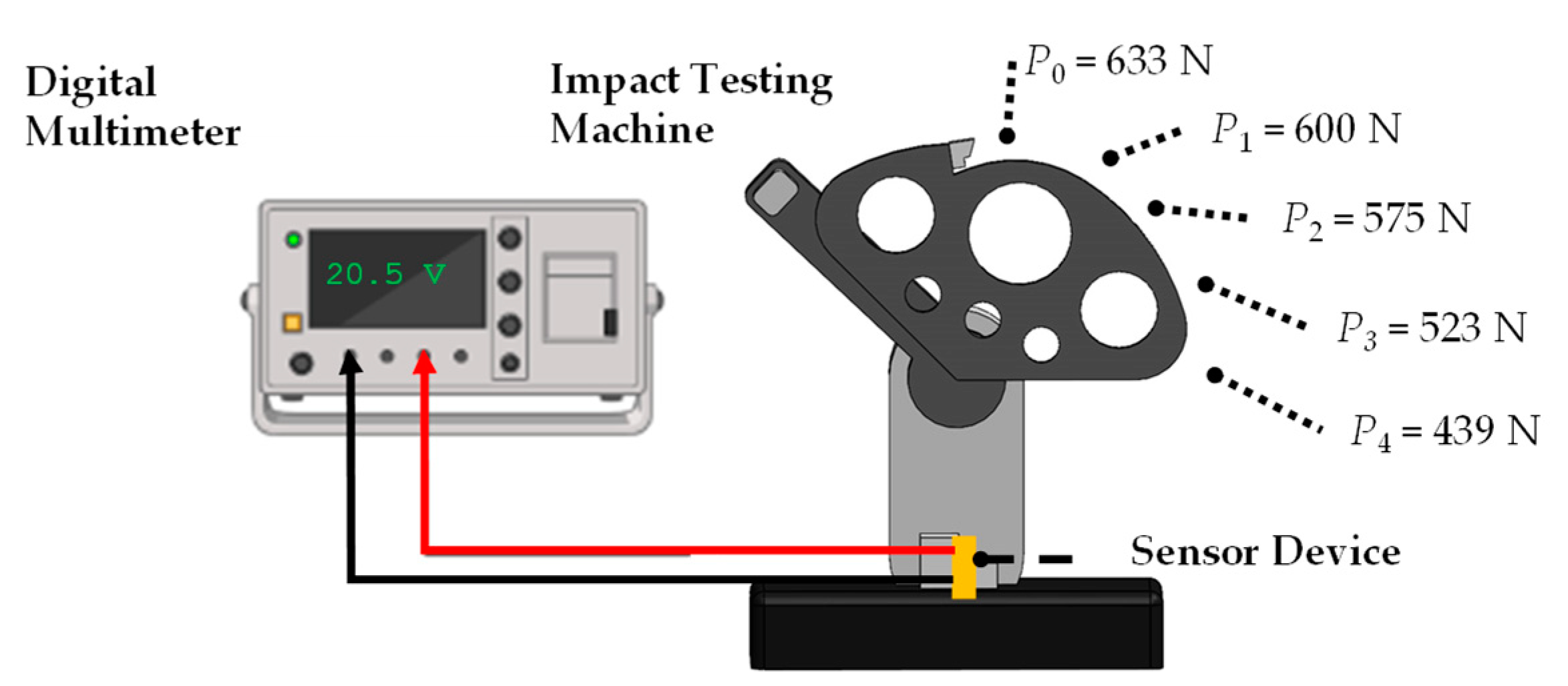
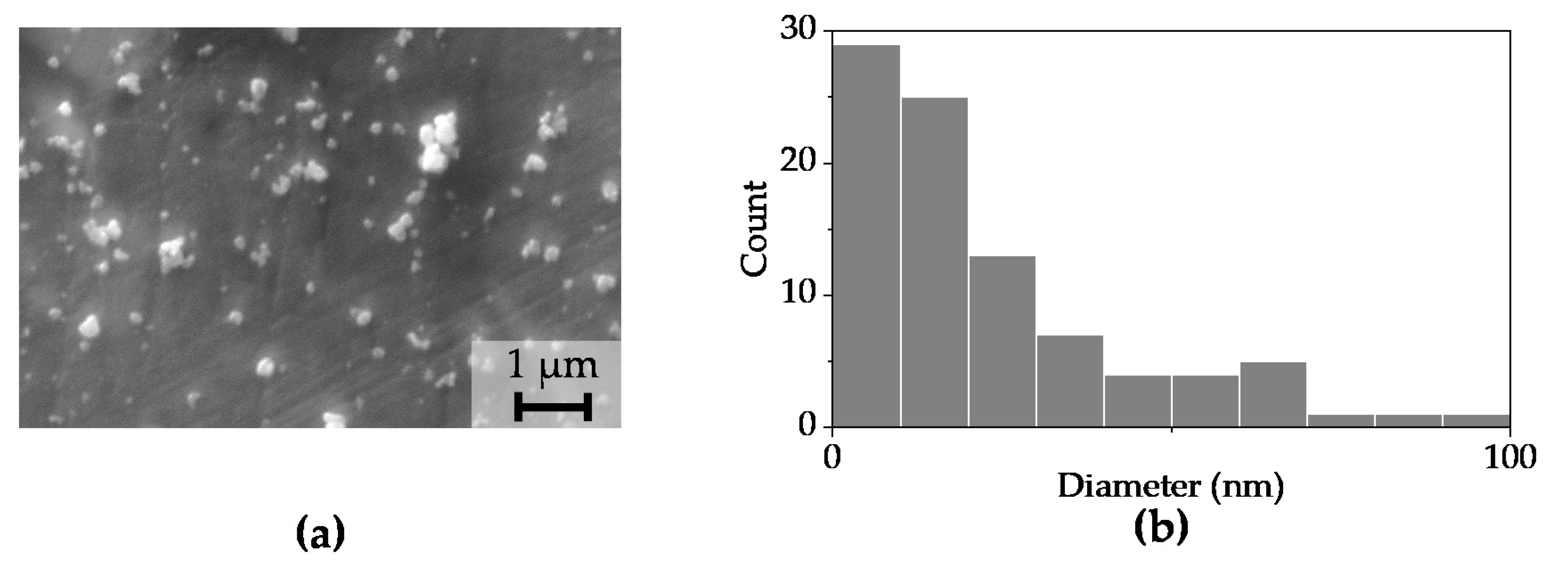
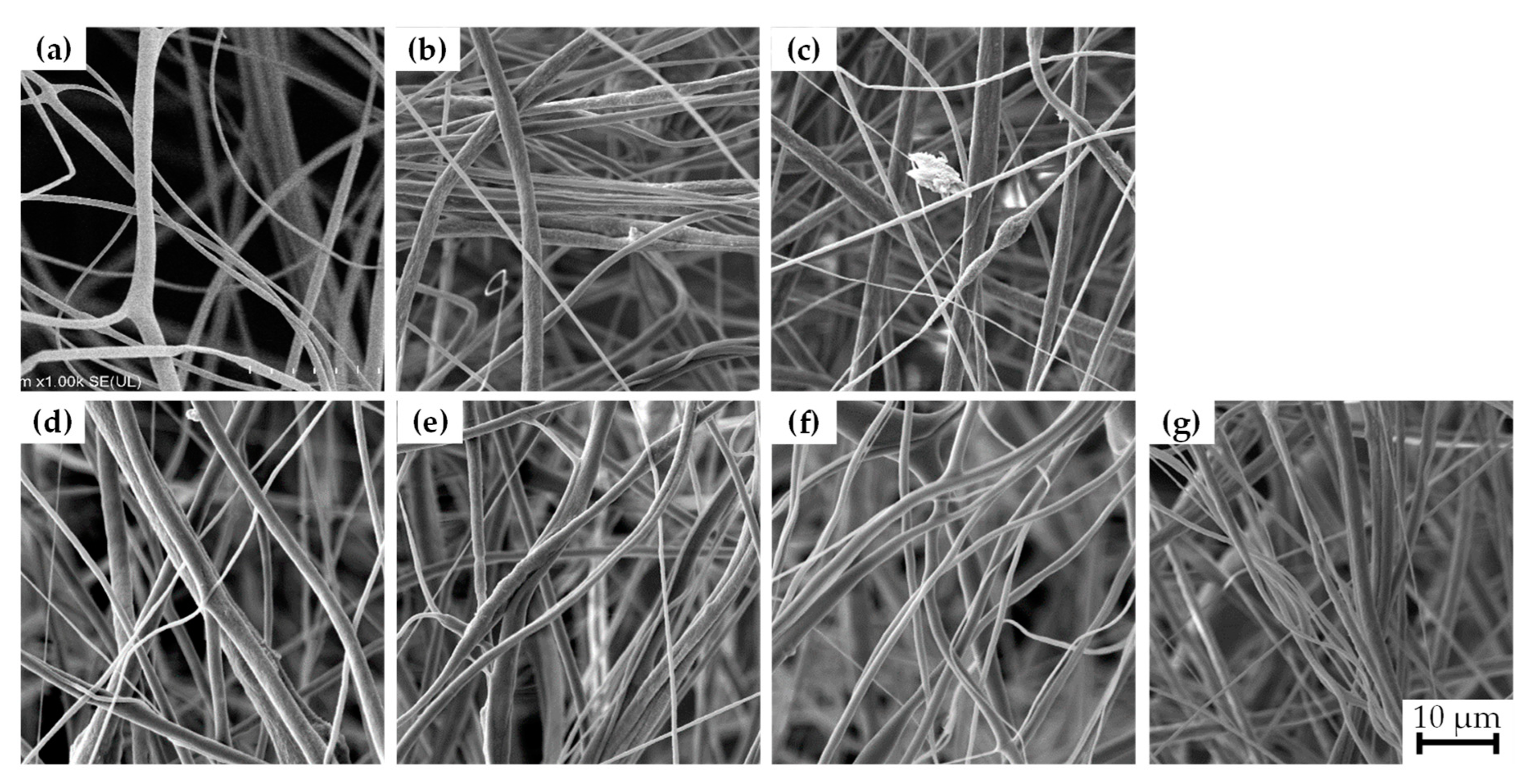

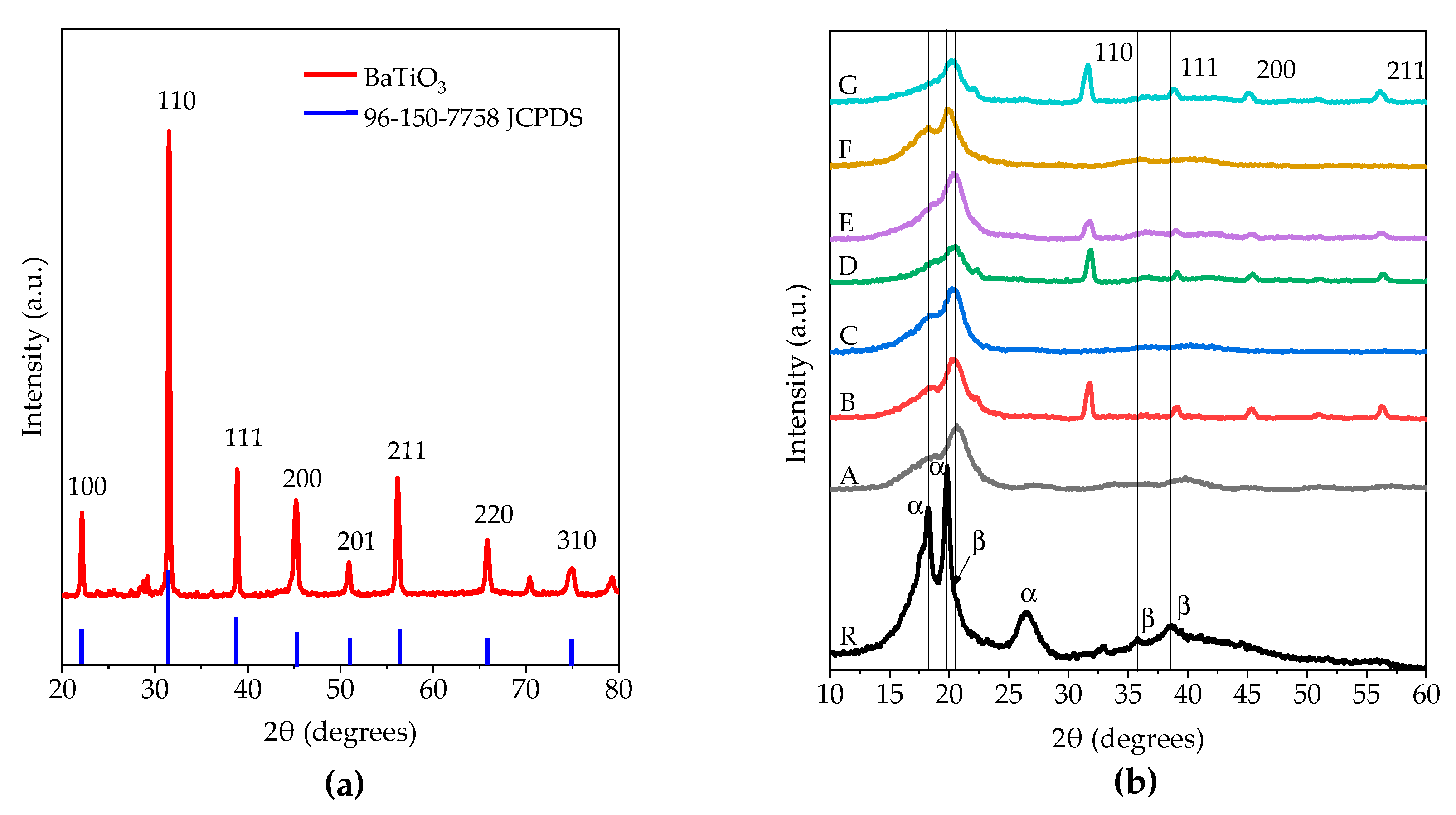


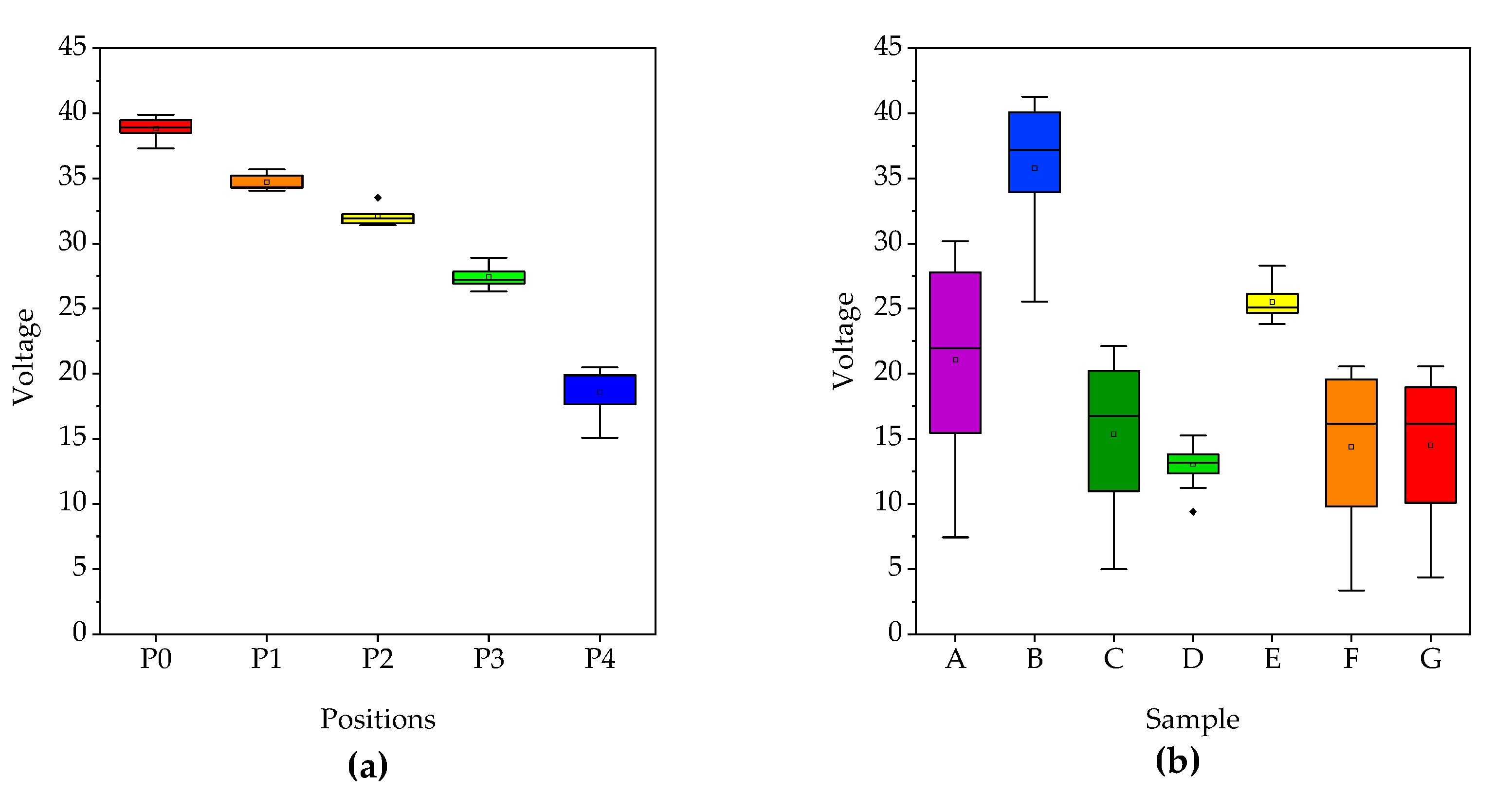
| PVDF Composite Samples | Description | PVDF (wt.%) | BaTiO3 (wt.%) | Graphene (wt.%) |
|---|---|---|---|---|
| R | PVDF powder | |||
| A | PVDF fiber | 15% | - | - |
| B | BaTiO3/PVDF | 15% | 15% | - |
| C | Graphene/PVDF | 15% | - | 0.05% |
| D | BaTiO3/Graphene/PVDF | 15% | 15% | 0.05% |
| E | BaTiO3/PVDF | 15% | 5% | - |
| F | Graphene/PVDF | 15% | - | 0.15% |
| G | BaTiO3/Graphene/PVDF | 15% | 5% | 0.15% |
| Key | Solution | Diameter Value (μm) |
|---|---|---|
| A | PVDF | 1.6 |
| B | BaTiO3/PVDF | 1.4 |
| C | Graphene /PVDF | 1.4 |
| D | BaTiO3/Graphene/PVDF | 1.1 |
| E | BaTiO3/PVDF | 1.0 |
| F | Graphene/PVDF | 1.2 |
| G | BaTiO3/Graphene/PVDF | 1.2 |
| Phase | Wavenumber (cm−1) | Functional Group | Vibrational Mode |
|---|---|---|---|
| α | 489 | CF2 | Waging |
| β | 510 | CF2 | Bending |
| α | 533 | CF2 | Bending |
| α | 615 | CF2 | Bending |
| α | 764 | CF-CH-CF | Skeletal bending |
| α | 795 | CH2 | Rocking |
| β | 840 | CH2, CF2, C-C | Rocking, stretching, skeletal stretching |
| α | 975 | CH2 | Rocking |
| α | 1149 | CF | Stretching |
| β | 1276 | --- | --- |
| α | 1382 | --- | --- |
| Samples | Aα | Aβ | β | β Percentage | T10% (°C) | Tp (°C) |
|---|---|---|---|---|---|---|
| R | 0.1676 | 0.119 | 0.36 | 36.0% | - | - |
| A | 0.0233 | 0.1371 | 0.823 | 82.3% | 456.8 | 482.6 |
| B | 0.0225 | 0.1242 | 0.814 | 81.4% | 473.1 | 498.8 |
| C | 0.026 | 0.1206 | 0.786 | 78.6% | 455.5 | 483.3 |
| D | 0.0303 | 0.1652 | 0.812 | 81.2% | 468.5 | 492.9 |
| E | 0.0195 | 0.1106 | 0.818 | 81.8% | 466.8 | 490.5 |
| F | 0.0219 | 0.1062 | 0.793 | 79.3% | 458.2 | 483.9 |
| G | 0.0191 | 0.1176 | 0.83 | 83.0% | 472.3 | 492.4 |
| Sample | A | B | C | D | E | F | G |
|---|---|---|---|---|---|---|---|
| Maximum OutputVoltage (V) | 21.0 | 35.8 | 15.3 | 13.0 | 25.5 | 14.4 | 14.5 |
| Sensitivity (V/N) | 7.6 | 12.91 | 5.5 | 4.7 | 9.2 | 5.2 | 5.2 |
| d33 (pC/N) | 16.0 | 19.4 | 13.8 |
Disclaimer/Publisher’s Note: The statements, opinions and data contained in all publications are solely those of the individual author(s) and contributor(s) and not of MDPI and/or the editor(s). MDPI and/or the editor(s) disclaim responsibility for any injury to people or property resulting from any ideas, methods, instructions or products referred to in the content. |
© 2023 by the authors. Licensee MDPI, Basel, Switzerland. This article is an open access article distributed under the terms and conditions of the Creative Commons Attribution (CC BY) license (https://creativecommons.org/licenses/by/4.0/).
Share and Cite
Aguirre-Corona, R.W.; Del Ángel-Sánchez, K.; Ulloa-Castillo, N.A.; Rodríguez-Salinas, J.J.; Olvera-Trejo, D.; Perales-Martínez, I.A.; Martínez-Romero, O.; Elías-Zúñiga, A. β-Phase Enhancement of Force Spun Composite Nanofibers for Sensing Applications. Polymers 2023, 15, 3580. https://doi.org/10.3390/polym15173580
Aguirre-Corona RW, Del Ángel-Sánchez K, Ulloa-Castillo NA, Rodríguez-Salinas JJ, Olvera-Trejo D, Perales-Martínez IA, Martínez-Romero O, Elías-Zúñiga A. β-Phase Enhancement of Force Spun Composite Nanofibers for Sensing Applications. Polymers. 2023; 15(17):3580. https://doi.org/10.3390/polym15173580
Chicago/Turabian StyleAguirre-Corona, Renato Wenceslao, Karina Del Ángel-Sánchez, Nicolás Antonio Ulloa-Castillo, Juan José Rodríguez-Salinas, Daniel Olvera-Trejo, Imperio Anel Perales-Martínez, Oscar Martínez-Romero, and Alex Elías-Zúñiga. 2023. "β-Phase Enhancement of Force Spun Composite Nanofibers for Sensing Applications" Polymers 15, no. 17: 3580. https://doi.org/10.3390/polym15173580







